

Teachers, Ideas and Mark Cuban: Adapting 'Shark Tanks' In Your School. Shark Tanks are making their way from the television screen to conferences and….schools?

At the CUE National Conference in Palm Springs, Calif. on March 17-19, six teachers pitched their big lesson ideas as part of “LeRoy’s Big Idea Challenge.” Up for grabs: a $2,500 grant. One of the key criteria used by judges to evaluate each idea was whether it was innovative, relevant and replicable. But you don’t have to wait for big education conferences to watch—or participate.
Developing a Shark Tank or Big Ideas competition in your school can help educators feel safer to test and try new and innovative teaching models. Why Ed Tech Is Not Transforming How Teachers Teach. Students in a classroom at Mount Pleasant High School in Wilmington, Del., listen to a social studies lecture from their teacher.
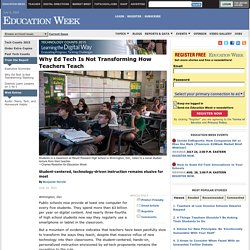
—Charles Mostoller for Education Week Student-centered, technology-driven instruction remains elusive for most Wilmington, Del. Public schools now provide at least one computer for every five students. They spend more than $3 billion per year on digital content. When the Computer Takes Over for the Teacher. Likewise, "blended learning"—in which students take at least part of a class online while supervised by adults—is now offered by about 70 percent of K-12 public-school districts.
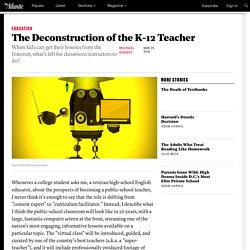
According the Clayton Christensen Institute—a nonprofit, nonpartisan think tank that touts "disruptive innovation"—the number of K-12 students who took an online course increased from roughly 45,000 in 2000, to more than 3 million in 2009. Education Technology: Is It All Hype With No Return? While some may regard the recent buzz around education technology as hype, it’s important to realize it is based on an element of hopefulness.
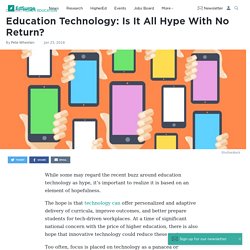
The hope is that technology can offer personalized and adaptive delivery of curricula, improve outcomes, and better prepare students for tech-driven workplaces. At a time of significant national concern with the price of higher education, there is also hope that innovative technology could reduce these costs. What Does Free Mean? It is not uncommon to chat with a group of teachers about a new product, and hear them proclaim something along the lines of: “If it’s not free, I won’t use it.”

We all love the idea of “free.” But as the adage goes, there is no such thing as a free lunch. Many edtech products are cloud-based, but that doesn’t mean the companies that build them run on air. When Educators Break Up With Companies by EdSurge On Air. “Lumilo” augmented reality glasses give teachers super powers. Editor’s note: This story led off this week’s Future of Learning newsletter, which is delivered free to subscribers’ inboxes every Wednesday with trends and top stories about education innovation.

Subscribe today! Robert Mawhinney’s math students each sat at their own computers, solving equations. As he looked around the room, he saw some students had smiley faces floating above their heads, some had question marks or exclamation points, and a few had Zzzs. He tapped the air in front of him and up popped a view of a student’s computer screen. Mawhinney is not an actor in a science fiction movie. The shape-shifting future of the mobile phone - Fabian. Fabian Hemmert describes ways that cell phones could become more human.
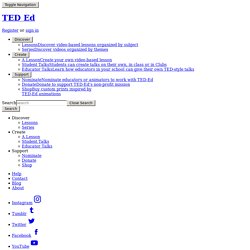
Learn more about the history of cell phones to see how far they've already come. Mobile devices will soon be breathing, growing, changing shape - what about smelling? Here is another concept for an eyes-free cell phone. And check out this fetus-like cell phone that tickles the viewer when a call comes in! Along with his shape-shifting mobile phones, Fabian Hemmert's newest work explores haptic feedback in pens. The Future of Wearable Technology. CUE Presents LeRoy's Big Idea 2016 Finalists. Tes. We are home to Tes, a professional collaboration and talent network of over 11.6 million education professionals worldwide.
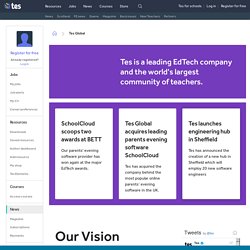
We are the market leading source of the latest news and information covering schools and the wider education sector and have been publishing news and opinion for over 100 years. We host a dynamic global marketplace hosting over 881,000 paid for and free classroom resources and lesson plans, which educators can discover, share and sell.
We provide a range of professional development and initial teacher training solutions for teachers through the Tes Institute; host a leading teacher and school leader jobs market, with innovative solutions for schools and candidates to make the process more efficient and better value; and provide supply teaching solutions to schools through Vision for Education, Smart Teachers and ABC Teachers. How Should Schools Purchase Ed. Tech? Commentary By Harold O.

Levy School districts across the United States spend billions of dollars every year on educational technology—buying everything from desktop, laptop, and tablet computers to apps, online courses, e-books, videos, and software. How to Have the Right Conversation With an Edtech Salesperson. I sell an edtech product, so I guess that makes this a sales call.
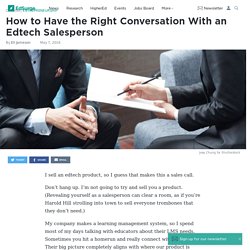
How One Researcher Uses Cost-Benefit Analysis to Rule Out the Worst Tools. School decision-makers are often faced with making choices amongst a variety of educational programs to serve their students. What criteria should apply in making such decisions? First, the decision-maker needs to assess whether the program is likely to help his or her particular students succeed. Ideally, evidence of program efficacy gathered from experimental studies demonstrates that students engaging in the program achieve better educational outcomes than students not engaging in the program. Second, the program must be affordable given prevailing budget constraints. 5 All-Too-Common Ways Edtech Implementations Fail. On the surface, adopting technology to support teacher needs or student challenges isn’t terribly complex: define the problem you’re trying to solve, identify the right tools for the job, and implement the tools effectively and with fidelity.
In practice, these areas are fraught with challenges. End users are too often removed from the decision-making process during procurement. Educators argue that too many products don’t actually meet the needs of teachers or students. Forget shopping. Soon you'll download your new clothes - Take a look at Danit Peleg’s other designs at her website: Danit Peleg 3D Printed Fashion. Wow! Five Myths About Classroom Technology (And What To Do, Instead)
Classroom technology is everywhere. Schools are filled with shiny, interactive devices, and new gadgets and apps flood the market every day. Mattel and Google teamed up to make VR kid friendly, and they got pretty darn close. Edtech Pilot Framework - A process to help run successful ed-tech pilots.